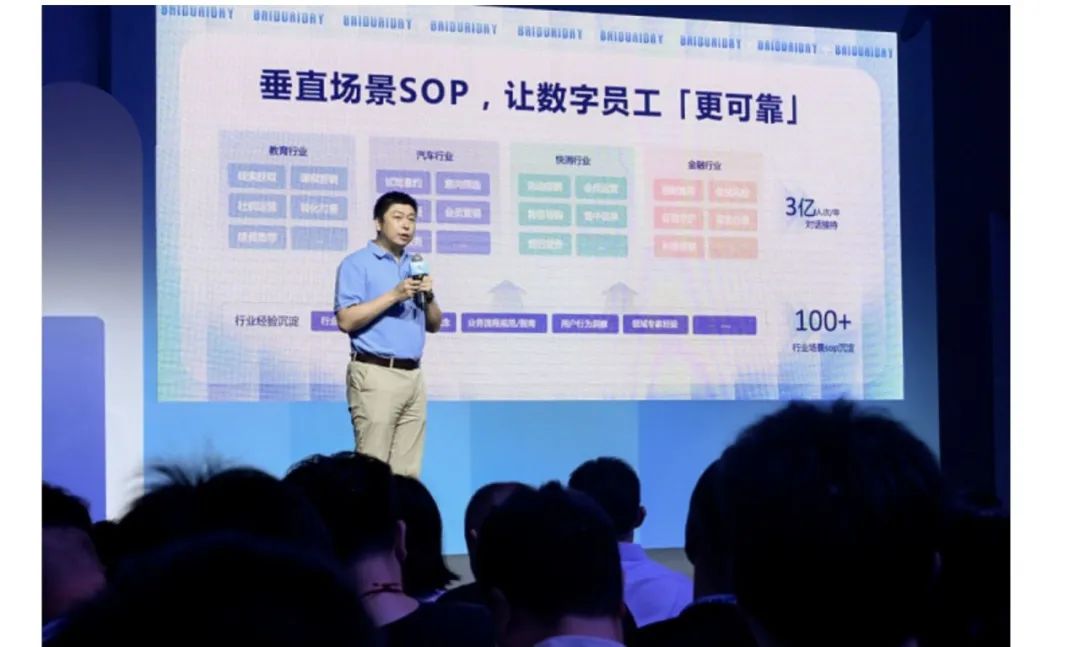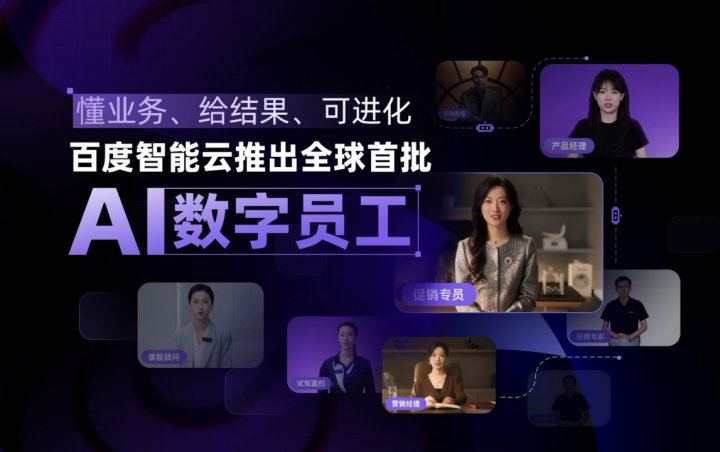The First Mature Answer Sheet of Digital Employees: Why Baidu Intelligent Cloud?
![]() 08/06 2025
08/06 2025
![]() 453
453

From a broader perspective, enterprises like Baidu Intelligent Cloud are advancing the implementation of AI. If previously, large models were seen as vertical large models or agents tailored to specific scenarios, now, with Baidu Intelligent Cloud's digital employee products, a clearer picture emerges: AI is not merely an assistant; it is an agent developed through enterprises' own exploration, evolving into a super employee that understands business, delivers results, and evolves.
Author | Piye
Produced by | Industry Home
In July in Beijing, heavy rains brought an unusual coolness. This month was also somewhat "special" for Baidu Intelligent Cloud. 'In the past 15 days, our overall official website traffic has surged by over 70%, and lead collection has doubled compared to the original model,' a relevant person in charge of Baidu Intelligent Cloud shared. These 'remarkable' increments stem from a special move: 15 days ago, Baidu Intelligent Cloud launched two digital employee products on its official website.
Digital employees are not an unfamiliar term. Over the past few years, digital employees have often been regarded as one of the primary forms of AI implementation, helping enterprises complete certain end-to-end tasks by assuming corresponding position KPIs.
However, even in 2025, the digital employee model is still not mature enough. 'The digital employees we currently access can only serve as customer service representatives, and even customer service is limited to front-end reception. Intermediate processes still require manual click confirmation. Strictly speaking, they are higher-level 'digital humans,' a CIO of a domestic retail service provider told us.
But this model is not what Baidu Intelligent Cloud envisioned. On August 5, Baidu Intelligent Cloud released its digital employee product series, with seven digital employee products making their debut, targeting the smallest position touchpoints such as sales, service, and recruitment. At the same time, numerous industry templates were released to officially open digital employee services to the public.
From the perspective of domestic internet giants and even broader, these are the world's first AI digital employees to debut.
Why Baidu Intelligent Cloud? Or what is special about the digital employees released by Baidu Intelligent Cloud? And from agents to digital employees, what new thinking does this enterprise, which announced the first shot of domestic AI large models, now possess?
Behind these questions, a gradually emerging consensus is apparent: a new form of AI large model productivity has arrived.
I. Why Have Digital Employees Become a Consensus?
'Initially, customers just wanted a tool or a digital human image. Today, customers are responsible for the use of this thing, this tool, and the results of this image,' said Shi Zheng, General Manager of Baidu Intelligent Cloud's Intelligent Marketing Products.
What he said is precisely digital employees.
According to an Analysys report on digital employees, in 2024, the market size of digital employees exceeded 20 billion yuan. It predicts that between 2025 and 2030, 80% of rule-based industrial scenarios will be replaced by digital employees.
In fact, from the perspective of current more realistic market discussions and acceptance, this trend is even underestimated. 'Initially, we just wanted to provide a role for customers to help enterprises make good use of all tools and understand some proprietary scenarios, achieving a score of 90 in various capabilities,' a service provider told Industry Home in an interview. 'But before the explosion of large models, it was difficult to achieve using RPA+NLP.'
The change in water temperature comes from the explosion of AI large models. Further, it is after this year's DeepSeek open source, accompanied by the open source of the base large model, that enterprises began to actively have a 'digital human demand'. This is precisely the change that Shi Zheng has felt.
In Shi Zheng's view, the three core elements of a true digital human product are industry SOPs, data/tools, and the front-end digital human image.
Industry SOPs ensure that digital employees can truly become a 'business-savvy' person, which means they need to understand the special business processes and logics of different enterprises, thereby being able to connect with front-end and back-end businesses to complete corresponding KPIs.
Data/tools correspond to the core foundation of digital employees, involving the current industry consensus on products such as agents, such as multi-agent collaboration, multi-modal recognition, and 'human-like' attributes of self-learning and self-evolution. These can ensure that they can not only understand the business of the enterprise itself but also keep pace with the times and evolve in tandem with changes in the enterprise's business.
Finally, there is the digital human. Shi Zheng told us that this is precisely the difference between digital employees and traditional customer service products, as it has a real and visible front-end digital human image that can be embedded as a role in the enterprise's workflow.
It can also be said that these three points also constitute a strong consensus on digital employees, whether from service providers or enterprises. Compared to the agent form that is more commonly deployed today, digital employees take a further step by being able to complete self-execution and result delivery of a specific link within the enterprise, such as sales leads, recruitment, and AI-based intelligent customer service.
But this is not an easy task. Behind digital employees lies a complex AI engineering system, which includes requirements for underlying large model capabilities, such as multi-modal recognition and multi-agent collaboration, as well as requirements for service providers' specific industry accumulation, meaning that only service providers with real industry understanding can 'infuse' workflows and industry semantics to make them industry experts.
At the same time, the front-end digital human is also an engineering point that seems simple but is actually complex. For example, the large gestures of digital humans, the integration and display of digital human base model capabilities, and the support of speech and language models are all capabilities that digital employee products must possess.
In addition, and most importantly, digital employees must possess the ability to self-learn and self-evolve, which means that digital employee products must have the ability to run a closed loop of 'real-scenario use - self-data training - ability evolution and upgrade'. Only in this way can they be guaranteed to be a real 'employee' in the perception and needs of the enterprise.
II. Baidu Intelligent Cloud
Behind a Mature Answer Sheet of a 'Marketing Partner'
This is precisely the effect that Baidu Intelligent Cloud's digital employee products aim to achieve.
From the perspective of specific product composition, among the seven AI digital employees that debuted for the first time from Baidu Intelligent Cloud, their business functions cover marketing managers, repayment assistants, car sales, promotion specialists, product managers, course consultants, and recruitment specialists.
Shi Zheng told us that the three core highlights of Baidu Intelligent Cloud's digital employees are - understanding business, delivering results, and evolving.
Understanding business corresponds to the understanding of business SOPs mentioned earlier. 'In personal growth, we often mention the 10,000-hour rule, and in our digital employee training process, for example, for outbound call representatives in 4S stores, we used 100,000 hours of training to enable them to reach the corresponding capabilities, and this duration is still accumulating,' said Zhang Hongguang, Deputy General Manager of Baidu Intelligent Cloud's Intelligent Marketing Products.

Delivering results is Baidu Intelligent Cloud's core setting for digital employees - autonomous execution and autonomous decision-making. This ranges from front-end voice/text recognition to intermediate judgment based on the dual-brain model of 'large model + small model', while autonomously invoking multiple agents for collaboration and orchestration to complete the output of results from the front-end KPI to the back end.
Evolving corresponds to the underlying setting of digital employees. At the product's foundation, Baidu Intelligent Cloud has set up a closed loop of roles of 'interaction - insight - optimization'. While Baidu Intelligent Cloud strengthens the underlying knowledge of job roles, digital employees can also self-learn and self-evolve in real business scenarios.
'The reason we prefer marketing scenarios is that it is currently the main scenario for verifying the commercialization capabilities of large models. The digital employees launched based on the entire marketing journey naturally possess the advantages of 'measurable value and high closed-loop efficiency', allowing enterprises to quickly feel their value,' Shi Zheng said.

He told us that it is also from the perspective of the entire journey that the role settings of Baidu Intelligent Cloud's digital employees are currently divided into three categories: customer service roles, sales roles, and roles based on customer data for insight and analysis. These three types of digital employees are distributed at different nodes of the entire marketing journey and can also cooperate with each other to jointly complete a specific marketing task.
It can be understood that behind the digital employees, Baidu Intelligent Cloud has constructed precisely the best practice of an enterprise-level agent, fully combining agents and digital humans to truly transform them into an executable, deliverable, and closed-loop productivity role, enabling enterprises to quickly deploy and get started.
In fact, above the entire product model and composition, this already formed end-to-end digital employee system is inherently an advantage of Baidu Intelligent Cloud.
For example, the two most important products - digital humans and intelligent customer service - are supported by Baidu Intelligent Cloud's Xiling digital humans and Baidu Intelligent Cloud's Keyue team at the underlying technology level. The former has repeatedly achieved first place in China's market share in IDC's evaluations, and the latter has also been selected for Sullivan's annual AI Agent list, serving large KA enterprises such as Mercedes-Benz and State Grid.
Another example is the interaction side mentioned earlier. It is understood that behind the digital employee products lies Baidu's industry-first end-to-end speech and language large model based on Cross-attention technology, which ensures that digital employees can understand and comprehend in a very short time and output the most suitable emotions and feedback based on the text, with a speech recognition accuracy rate of 98% and a dialogue delay reduced to within 1 second.
In addition to these, from computing power to agents, from technology to data, and from data to specific industry semantic expressions, and other full-stack AI systems, these are all sufficiently refined atomic manifestations in Baidu Intelligent Cloud's digital employee products.
'Enterprises can choose corresponding products according to their different needs. For example, large KA enterprises can choose customized digital humans, and we will help enterprises customize the image of digital humans and conduct deeper industry training accordingly; if it is a small or medium-sized enterprise, it can directly select the corresponding digital employee on the official website and configure it based on the industry scenario templates we provide, allowing for rapid deployment and use.'
One statistic is that as of now, at the bottom of the scene configuration for digital employees, Baidu Intelligent Cloud has configured over 100 scenarios, covering specific scenario directions in different industrial tracks such as education, fast-moving consumer goods, and finance.
'Now we have only constructed digital employee roles in some scenarios. Next, as the capabilities of large models improve, we will select more segmented scenarios for implementation, allowing enterprises to truly have their own 'marketing partners.'
III. From Product Technology to Result Delivery
Redefining AI Implementation
In the past three years of the AI large model wave, a proposition that has been continuously discussed is: what form of AI is truly a productivity model? Is it a copilot assistant, an agent, or something else like edge intelligence?
Baidu Intelligent Cloud is delivering this answer sheet.
It can be understood that behind the consensus on digital employees, their greater value lies in their ability to quantify and perceive AI technology and AI investment at the level of true results. Through a comprehensive model of 'model technology + scenario understanding + front-end digital human form', they can take a further step based on current agents, truly moving from delivering tools to delivering results, genuinely helping enterprises complete the value expression of AI and build their core business competitiveness.
In fact, Baidu itself has already been a validator of this special answer sheet.
A real case is that since the launch of the Netizen Rights Protection Plan in 2013, the customer service staff of Baidu's protection team have provided protection services for thousands of users every day, and some problems have arisen.
For example, in front-end standardized reception, due to the involvement of a large number of fixed processes and professional terminology, repeated confirmation and answers are required, which consumes a lot of energy from the customer service team; moreover, in the subsequent research and judgment mediation link, due to its high professionalism but less resource investment, the problem of uneven resource allocation frequently occurs.
Furthermore, the customer service sector frequently grapples with the challenge of nurturing professional talent, as novice customer service representatives often require extensive training spanning several weeks to months to proficiently manage intricate business processes.

Baidu's innovative solution involves integrating Baidu Intelligent Cloud's digital employees into its protection team. Current data reveals that following the deployment of these digital employees, the service efficiency of Baidu's protection team has experienced significant growth: timeliness has improved by 18 hours, and the success rate of user protection applications has surged by 60%.
This success extends beyond Baidu itself. Shi Zheng informed us that this unique approach has already been rolled out across Baidu Intelligent Cloud's customer base. Today, digital employees from Baidu Intelligent Cloud are operational in high-frequency industry segments served by the platform, encompassing finance, automotive, and education.
"We envision that in the Agentic era, an increasing number of novel 'workers' will emerge in daily operations, with intelligent agents functioning as 'digital employees' across various facets of enterprise operations," said Ruan Yu, Vice President of Baidu. "As productive units, digital employees will catalyze transformative changes in organizational productivity."
From a broader perspective, companies like Baidu Intelligent Cloud are pushing the boundaries of AI implementation. Previously, large models were viewed as vertical or scenario-specific agents. However, beyond Baidu Intelligent Cloud's digital employee offerings, a clearer picture emerges: AI is evolving beyond being merely an assistant; it is becoming an agent tailored by enterprises through their own explorations. These AI agents are transforming into super employees that comprehend business nuances, deliver tangible results, and continuously evolve.
Moreover, this evolution is ongoing. "As our digital employees are now operational in specific industries, they will continually accumulate and refine data, adopt industry standard operating procedures (SOPs), and enhance their capabilities. With the support of this data-driven momentum, these digital employees will undoubtedly become increasingly powerful," added Ruan Yu.
From human-machine collaboration to intelligent collaboration, and from mere tool enhancement to genuine result-driven empowerment, a new era of productivity revolution is gathering pace.








